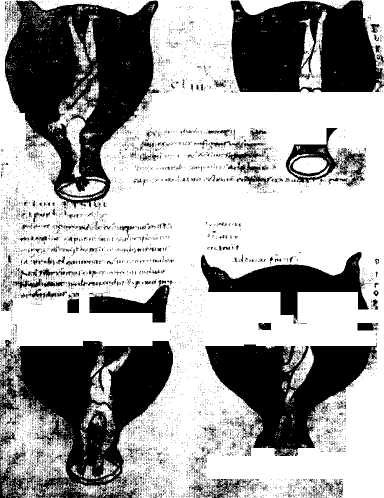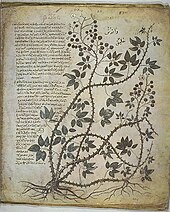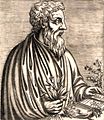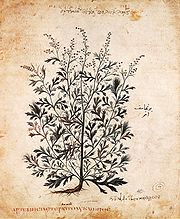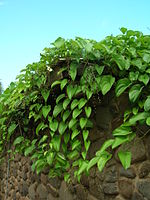Развитие медицинских знаний
Римская
наука периода Империи имела
эмпирическо-описательный и прикладной
характер, свойственный римскому
практицизму. Вобрав в себя достижения
всех народов Средиземноморья, римское
энциклопедическое знание сформировалось
в результате трансформации и взаимного
проникновения древнегреческой и
восточных культур. Наиболее ярко эти
тенденции выразились в многотомной
(более 20 томов) энциклопедии «Искусства»
(«Artes»)
на
латинском
языке, которую составил Авл
Корнелий Цельс (Aulus
Cornelius Celsus, 30/25
гг. до н.э. — 45/50 гг. н.э.). До нас дошли
лишь восемь томов (VI
—XIII), посвященные
медицине («De
medicina» (рис.
78). Созданный около 30 г. н.э., этот
труд является самым
ранним (из
известных нам) медицинским
сочинением на
латинском языке. Его
рукописный текст был обнаружен в середине
XV
в.
(ок.
1443 г.) и впервые издан во Флоренции в
1478 г.
Будучи
широко образованным человеком и богатым
рабовладельцем, Цельс привлек
большой штат переводчиков и копиистов,
которые переводили многочисленные
труды по философии, риторике, праву,
медицине, сельскому хозяйству
и военному делу греческих, александрийских,
индийских и других
1
Медицина в поэзии греков и римлян /
Сост., вступ. слово и примеч. Ю.Ф. Шульца.
— М.: Медицина,
1987. — С. 34.
168
авторов.
Многие из этих сочинений до наших дней
не сохранились, и мы знаем о них
только благодаря Цельсу, например,
о трудах Герофила и Эраси-страта без
трактата Цельса в истории александрийской
врачебной школы был
бы существенный пробел.
Согласно
Галену, Цельс составлял свое
«практическое руководство, занимаясь
лечением больных в своем валету
динарии (для
рабов)». Он подробно изложил
достижения римской медицины
периода Ранней Империи в области
диететики, гигиены, теории болезни,
терапии и особенно хирургии. Приведенное
им описание четырех признаков
воспаления (покраснение, припухлость,
жар и боль), как полагают исследователи,
заимствовано из древних индийских
трактатов; однако ими не могли
быть самхиты Чараки и Сушру-ты,
так как современная наука датирует
эти сочинения II
и
IV
вв.
н.э., а Цельс
составил свою энциклопедию во времена
императора Тиберия (Тиберий Цезарь
Август, 24—37 гг.), т.е. в начале
I
в.
Трактат Цельса внес существенный
вклад в развитие научной латинской
терминологии (после Т.Лукреция).
Его
язык, по мнению Плиния Старшего,
классический — «золотая латынь».
Плиний
Старший (Plinius
Secundus, 24—79
гг.) видный представитель энциклопедического
направления в римской
прозе, писатель, ученый и государственный
деятель. Плиний отличался
исключительной пытливостью в наблюдении
природы (он и погиб во время
извержения вулкана Везувия, которое
наблюдал с борта корабля, настойчиво
приближая его к вулкану). Из многочисленных
трудов Плиния сохранилась
лишь «Естественная история» («Historia
naturalise) в
37 книгах; в ней обобщены
знания того времени по астрономии,
географии, истории, зоологии,
ботанике, сельскому хозяйству,
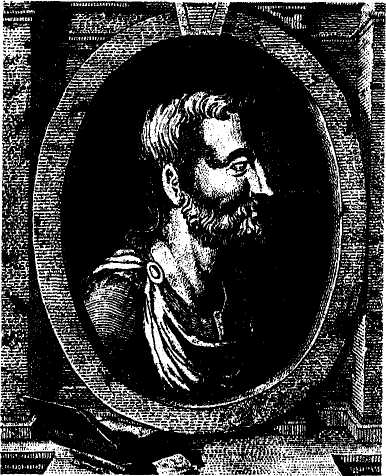
А
ГИЕЫ1
COR
CELSI
DE
КБ
MEDI-
С
A
LIBRI
О
С Т О.
*
q.
j
t
к
INI
medicinale Pocmi. ahemnii
Poem»dcPond.&menfuri«.
Cm
Adnetitionibtn cr
CorreHionibut
R. CONSTAMIIH1.
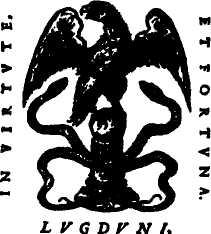
APVD
GVL1EL. ROVILLIYM, m
scvio
veneto.
M
,
D. LXVI.
СУМ
PRiriLEClO.
Р
ис.
78. Авл Корнелий Цельс (гравюра из издания
1765 г.) и титульный лист его многотомного
труда «О медицине». Лион, 1566 г.
169
d
d
ioscoridis
I, DE
MEDICA
MATER1A
IIIII
SEX,
loanne
ivuno Snefsionenfi interpret*.
HIS
ACCESSIT,
PR.AETER
TbarmtKorum fmflitium
catalojum,
copiofiu ommifermi
nudela,.
rum fine curaiionun
Indtx.
медицине,
минералогии (Плиний проанализировал
свыше двух тысяч сочинений
более чем 400 авторов). Обзору медицинских
знаний посвящены книги
XXIII
—XXVII
его
труда. Лекарства животного
происхождения описаны в книгах
XXVIII—XXXII.
На
протяжении многих
веков «Естественная история» Плиния
была одним из основных источников в
области наук о природе.
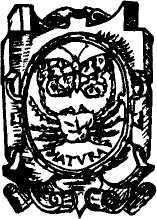
Наряду
с естественно-научными знаниями
Плиний изложил и представления
парадоксографов и даже народные
поверья. Это соответствует традиции
книжного энциклопедического
знания, характерного для поздней
античности.
I
V С
D
V X 1,
Apud Ioannem Frellonium,
М47
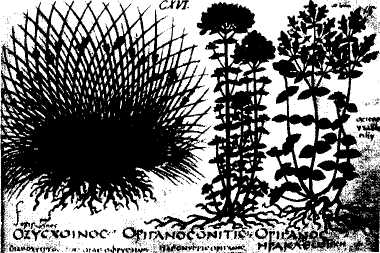
Так,
в книге VII
собраны
сведения
об аномалиях человеческой природы
(парадоксография): о рождении двойняшек
и тройняшек, о младенцах-уродах
и даже о передаче признаков
из поколения в поколение в «четвертом
колене». Плиний пересказал также
суеверия и предрассудки того времени:
описал птицу-феникс и гип-покентавра,
которого, как он утверждает,
видел сам в набальзамированном виде.
Рис.
79. Труд Диоскорида «О лекарственных
средствах». Титульный лист издания
1547
г. и иллюстрация из рукописи VI
в.
Современником
Плиния был выдающийся
римский военный врач Ди-оскорид
Педаний из
Киликии (греч. Dioskurides,
лат.
Dioscorides
Pedanius, I
в.
н.э.), родом грек. Его сочинение «О
врачебной материи», т.е. о лекарственных
растениях («De
materia medico»)
(рис.
79), составленное на греческом
языке, содержит систематическое
описание более чем 600 лекарственных
растений, применявшихся в медицинской
практике во времена императоров
Клавдия (41 — 54 гг.) и Нерона (54 — 68
гг.). Труд Диоскорида пользовался
непререкаемым авторитетом вплоть до
XVI
в.
и сыграл значительную
роль в разработке систематики растений.
В Византийской империи, а затем
и на арабоязычном Востоке он был основным
источником знаний о растительном
мире. В средневековой Западной Европе
он появился в арабском
переводе.
170
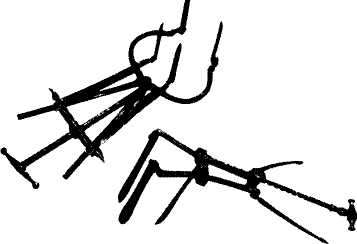
Рис.
80. Римские хирургические инструменты.
I
в.
н.э. Найдены в Помпеях. Неаполь.
Археологический музей
Самой
ценной из дошедших до нас копий
труда Диоскорида является иллюстрированный
манускрипт, переписанный
не позднее 512 г. по заказу граждан
Перры (предместье Константинополя);
они преподнесли этот труд Юлиане
Аникии, дочери цезаря Флавия
Онициуса, в знак благодарности за
основание
церкви. В настоящее время этот
экземпляр хранится в австрийской
Национальной
библиотеке в Вене, откуда
и получил свое название — «Венский
Диоскорид».
О
развитии хирургии
в
Риме в период
Империи свидетельствуют наборы
хирургических инструментов, найденные
при раскопках древних городов: в «доме
хирурга» в Помпеях (рис. 80), в Бадене,
Бингене, Херсонесе и Ольвии (на территории
Крыма) и др. В наборы входили пинцеты,
щипцы, захваты, ложки,
ранорасширители, пилы для костей,
хирургические ножи и иглы, катетеры,
акушерские зеркала и другие инструменты,
использовавшиеся в хирургии
и акушерско-гинекологической практике.
Самое
обширное во всей древней литературе
сочинение по родовспоможению,
гинекологии и болезням детского возраста
составил Соран
(греч.
Soranos,
лат.
Soranus,
98—
138 гг.) родом из Эфеса (рис. 81), греческий
врач, практиковавший
в Риме в начале II
в.
Из 20 написанных им сочинений до нас
дошли труды
«Гинекология», «О повязках», «О переломах».
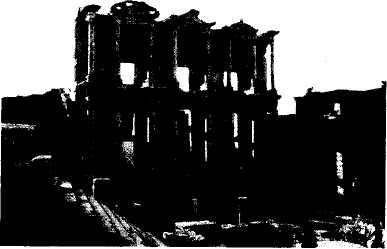
Соран
придерживался взглядов методической
медицинской школы. В про
цессе
родовспоможения он старался максимально
отойти от грубых и насиль
ственных
методов, описал приемы предупреждения
разрыва промежности,
поворот
плода на ножку и головку (рис. 82), операцию
эмбриотомии, разраба
тывал
различные методы обследования
(прощупывание, простукивание, выс
лушивание
звуков в области располо
жения
плода, исследование пульса,
мокроты,
мочи). Большое внимание он
уделял
уходу за детьми в раннем воз
расте:
диететике младенцев, правилам
кормления
грудью и т.д. В последую
щие
эпохи сочинения Сорана получи
ли
широкое распространение на Ближ
нем
Востоке и в Западной Европе и
вплоть
до XVIII
в.
считались основным
источником
знаний по родовспоможе
нию,
гинекологии и лечению детей ран
него
возраст Рис.
81. Библиотека Цельсия в г. Эфес, род-
В
период Поздней Империи судьбы ном
городе
Сорана
построена при его жиз-римскои
культуры, в том числе фило- Ни
в 135 г. н. э. в честь губернатора Азиатской
софии,
естествознания и медицины, провинции
Римской империи Ц.Цельсия, во
многом определялись общим поли-
Фото предоставлено автором. 1996 г.
171
I
%
тическим
и экономическим кризисом.
В результате во многих отраслях есте-
ствознания обострились дуалистические
<<^^_
■ ^^_< (лат. dualis
—
двойной, двойственный)
{‘.,’11
‘.:1£.^^НЙЁ^г*** тенденции. Философия
дуализма при-
‘*^ЯЗ
‘
^ знает два самостоятельных начала —
дух
и
материю, идеальное и материальное.
•,,-tt.,,».,- —
■ Противоречия,
свойственные поздней
™,Л.,»,».’,ГГ .«V»,-li«.
античной
науке, ярко проявились в трудах
r.V»«„„’,’„■;it»».*,»‘X..
вьщающегося
астронома, астролога и ма-
тематика античности Птолемея из Птоле-
миады (Ptolemaeus,
83
— 116 гг.). Он создал
^^^jjj ^^Н^^^^^к
выдающееся произведение «Великое
Ma-
s’
^^^^В^^^Я
[^^Кг^П^^^Н тематическое построение
астрономии» в
‘ ^ книгах
(в
арабском переводе оно извес-
-‘
тно
как
^^magest*)-
в
котором обосновал
-‘ Д принятое в то время учение о
геоцентри-
ческой системе движения планет (оно
су-
ществовало
в науке до 1543 г., когда было
‘»%*’
^«*^
-‘*,’* опровергнуто Н.Коперником,
обосновав-
‘^Й шим
гелиоцентрическую систему). Имен
но
Птолемею принадлежит одно из круп-
Рис.
82. Варианты неправильного предле-
нейших произведений античной астроло-
жания
плода в матке. Иллюстрация из гии
«Четверокнижие» («Tetrabiblos»),
в
ко-
Брюссельской
рукописи труда Сорана из ТОром
изложены представления о влиянии
Эфеса.
Около 900 г. небесных
тел на человечество, материки и
природные
явления в целом. В Римской империи
астрология была в большом почете.
Астрологов приглашали на службу ко
двору. Их
главной задачей было составление
гороскопов.
Подобная
двойственность в мировоззрении была
свойственна многим ученым
периода поздней античности. В области
медицины этот дуализм ярко проявился
в деятельности величайшего врача
Древнего мира — Галена.
Соседние файлы в предмете [НЕСОРТИРОВАННОЕ]
- #
- #
- #
- #
- #
- #
- #
- #
- #
- #
- #
|
Pedanius Dioscorides |
|
|---|---|

Dioscorides receives a mandrake root, an illumination from the 6th century (c. 512) Greek Juliana Anicia Codex |
|
| Born | c. 40 AD[1]
Anazarbus, Cilicia, Asia Minor |
| Died | c. 90 AD |
| Other names | Dioscurides |
| Occupation(s) | Army physician, pharmacologist, botanist |
| Known for | De Materia Medica |
Pedanius Dioscorides (Greek: Πεδάνιος Διοσκουρίδης, Pedánios Dioskourídēs; c. 40–90 AD), “the father of pharmacognosy”, was a Greek physician, pharmacologist, botanist, and author of De materia medica (Περὶ ὕλης ἰατρικῆς, On Medical Material) —a 5-volume Greek encyclopedia about herbal medicine and related medicinal substances (a pharmacopeia), that was widely read for more than 1,500 years. For almost two millennia Dioscorides was regarded as the most prominent writer on plants and plant drugs.[2][3]
Life[edit]
A native of Anazarbus, Cilicia, Asia Minor, Dioscorides likely studied medicine nearby at the school in Tarsus, which had a pharmacological emphasis, and he dedicated his medical books to Laecanius Arius, a medical practitioner there.[a][5][6] Though he writes he lived a «soldier’s life» or «soldier-like life», his pharmacopeia refers almost solely to plants found in the Greek-speaking eastern Mediterranean, making it likely that he served in campaigns, or travelled in a civilian capacity, less widely as supposed.[7][5] The name Pedanius is Roman, suggesting that an aristocrat of that name sponsored him to become a Roman citizen.[8]
De materia medica[edit]
Between AD 50 and 70 [9] Dioscorides wrote a five-volume book in his native Greek, Περὶ ὕλης ἰατρικῆς (Perì hylēs íatrikēs), known in Western Europe more often by its Latin title De materia medica («On Medical Material»), which became the precursor to all modern pharmacopeias.[10]
In contrast to many classical authors, Dioscorides’ works were not «rediscovered» in the Renaissance, because his book had never left circulation; indeed, with regard to Western materia medica through the early modern period, Dioscorides’ text eclipsed the Hippocratic corpus.[11]
In the medieval period, De materia medica was circulated in Greek, as well as Latin and Arabic translation.[12]
While being reproduced in manuscript form through the centuries, it was often supplemented with commentary and minor additions from Arabic and Indian sources. Ibn al-Baitar’s commentary on Dioscorides’ De materia medica, entitled Tafsīr Kitāb Diāsqūrīdūs: تفسير كتاب دياسقوريدوس, has been used by scholars to identify many of the flora mentioned by Dioscorides.[13]
A number of illustrated manuscripts of De materia medica survive. The most famous of these is the lavishly illustrated Vienna Dioscurides, produced in Constantinople in 512/513 AD. Densely illustrated Arabic copies survive from the 12th and 13th centuries, while Greek manuscripts survive today in the monasteries of Mount Athos.[14]
De materia medica is the prime historical source of information about the medicines used by the Greeks, Romans, and other cultures of antiquity. The work also records the Dacian,[15] Thracian,[16] Roman, ancient Egyptian and North African (Carthaginian) names for some plants, which otherwise would have been lost. The work presents about 600 plants in all,[17] although the descriptions are sometimes obscurely phrased, leading to comments such as: «Numerous individuals from the Middle Ages on have struggled with the identity of the recondite kinds»,[18] while some of the botanical identifications of Dioscorides’ plants remain merely guesses.
De materia medica formed the core of the European pharmacopeia through the 19th century, suggesting that «the timelessness of Dioscorides’ work resulted from an empirical tradition based on trial and error; that it worked for generation after generation despite social and cultural changes and changes in medical theory».[11]
The plant genus Dioscorea, which includes the yam, was named after him by Linnaeus. A butterfly, the Bush hopper, Ampittia dioscorides which is found from India southeast towards Indonesia and east towards China, is named after him.[19]
Gallery[edit]
-
Later representation of Dioscorides
-
Dioscorides as depicted in a 1240 Arabic edition of De materia medica
Translations[edit]
- De Materia Medica: Being an Herbal with many other medicinal materials. Translated by Tess Anne Osbaldeston; based on the 1655 translation of John Goodyer. Johannesburg: Ibidis Press. 2000 – via cancerlynx.com.
{{cite book}}: CS1 maint: others (link) - De Materia Medica. Translated by Lily Y. Beck. Olms-Weidmann: Hildesheim. 2005.
{{cite book}}: CS1 maint: others (link) - Gunter, R. T., ed. (1933) [1655]. The Greek Herbal of Dioscorides... Translated by John Goodyer.
- De Materia Medica : libri V Eiusdem de Venenis Libri duo. Translated by Iano Antonio Saraceno Lugdunaeo (Janus Antonius Saracenus). 1598 – via digitale-sammlungen.de.
{{cite book}}: CS1 maint: others (link)
See also[edit]
- Materia medica
- Dioscorea
Notes[edit]
- ^ The dedication, translated by Scarborough and Nutton,[4] began «At your insistence I have assembled my material into five books, and I dedicate my compendium to you in fulfilment of a debt of gratitude for your sentiments towards me».[5]
References[edit]
- ^ «Pedanius Dioscorides». Encyclopaedia Britannica. September 27, 2013. Retrieved July 4, 2020 – via britannica.com.
- ^ Bauer Petrovska, Biljana (2012). «Historical review of medicinal plants’ usage». Pharmacognosy Reviews. 6 (11): 1–5. doi:10.4103/0973-7847.95849. PMC 3358962. PMID 22654398.
- ^ Osbaldeston, Tess Anne (2008). «De Materia Medica — Pedanius Dioscorides -«. Retrieved 11 November 2022.
- ^ Scarborough and Nutton, 1982
- ^ a b c Stobart, Anne (2014). Critical Approaches to the History of Western Herbal Medicine: From Classical Antiquity to the Early Modern Period. A&C Black. p. 193. ISBN 978-1-4411-8418-4.
- ^ Borzelleca, Joseph F.; Lane, Richard W. (2008). «The Art, the Science, and the Seduction of Toxicology: an Evolutionary Development». In Hayes, Andrew Wallace (ed.). Principles and methods of toxicology (5th ed.). Taylor & Francis. p. 13.
- ^ Nutton, Vivian. Ancient medicine. Routledge, 2012. p. 178
- ^ Tobyn, Graeme; Denham, Alison; Whitelegg, Midge (2016). The Western Herbal Tradition: 2000 Years of Medicinal Plant Knowledge (illustrated ed.). Singing Dragon. p. 4. ISBN 9780857012593.
- ^ «Greek Medicine». National Institutes of Health, USA. 16 September 2002. Retrieved 1 July 2013.
- ^ Rooney, Anne (2012). The History of Medicine. The Rosen Publishing Group. p. 121. ISBN 9781448873708.
- ^ a b De Vos (2010) «European Materia Medica in Historical Texts: Longevity of a Tradition and Implications for Future Use», Journal of Ethnopharmacology 132(1):28–47
- ^ Some detail about medieval manuscripts of De Materia Medica at pages xxix–xxxi in Introduction to Dioscorides Materia Medica by TA Osbaldeston, year 2000.
- ^ Zohar Amar, Agricultural Produce in the Land of Israel in the Middle Ages (Hebrew title: גידולי ארץ-ישראל בימי הביניים), Ben-Zvi Institute: Jerusalem 2000, p. 270 ISBN 965-217-174-3 (Hebrew); Tafsīr Kitāb Diāsqūrīdūs — commentaire de la “Materia Medica” de Dioscoride de Abū Muḥammad ʻAbdallāh ibn Aḥmad ibn Muḥammad ibn al-Bayṭār de Malaga (ed. Ibrahim Ben Mrad), Beirut 1989 (Arabic title: تفسير كتاب دياسقوريدوس)
- ^ Selin, Helaine (2008). Encyclopaedia of the History of Science, Technology, and Medicine in Non-Western Cultures. Springer. p. 1077. ISBN 9781402045592.
- ^ Nutton, Vivian (2004). Ancient Medicine. Routledge.. Page 177.
- ^ Murray, J. (1884). The Academy. Alexander and Shephrard.. Page 68.
- ^ Krebs, Robert E.; Krebs, Carolyn A. (2003). Groundbreaking Scientific Experiments, Inventions, and Discoveries of the Ancient World. Greenwood Publishing Group.. Pages 75–76.
- ^ Isely, Duane (1994). One hundred and one botanists. Iowa State University Press.
- ^ Austin, Daniel F. (2004). Florida Ethnobotany (illustrated ed.). CRC Press. p. 267. ISBN 9780203491881.
Sources[edit]
- Allbutt, T. Clifford (1921). Greek medicine in Rome. London: Macmillan. ISBN 1-57898-631-1.
- Bruins: Codex Constantinopolitanus: Palatii Veteris NO. 1 [3 volume set] Part 1: Reproduction of the Manuscript; Part 2: Greek Text; Part 3: Translation and Commentary Bruins, E. M. (Ed.)
- Forbes, Andrew; Henley, Daniel; Henley, David (2013). ‘Pedanius Dioscorides’ in: Health and Well Being: A Medieval Guide. Chiang Mai: Cognoscenti Books.
- Hamilton, J. S. (1986). «Scribonius Largus on the medical profession». Bulletin of the History of Medicine. 60 (2): 209–216. PMID 3521772.
- Lazris, J.; Stavros, V. (2013). «L’image paradigmatique: des Schémas anatomiques d’Aristote au De materia medica de Dioscoride». Pallas. 93 (93): 131–164. doi:10.4000/pallas.1400.
- Lazris, J.; Stavros, V. «The medical illustration in Antiquity». Reality Through Image: 18–23 (abstract).
- Riddle, John (1980). «Dioscorides» (PDF). Catalogus Translationum et Commentariorum. 4: 1. Retrieved 25 August 2015.
- Riddle, John M. (1985). Dioscorides on pharmacy and medicine. Austin: University of Texas Press. ISBN 0-292-71544-7.
- Sadek, M. M. (1983). The Arabic materia medica of Dioscorides. Québec, Canada: Les Éditions du sphinx. ISBN 2-920123-02-5.
- Scarborough, J.; Nutton, V. (1982). «The Preface of Dioscorides’ Materia Medica: introduction, translation, and commentary». Transactions & Studies of the College of Physicians of Philadelphia. 4 (3): 187–227. PMID 6753260.
External links[edit]
- Works by Dr. Dioscorides at Project Gutenberg
- Works by or about Pedanius Dioscorides at Internet Archive
- Works by Dioscorides
- Dioscorides Materia Medica, in English—the full book downloadable in PDF fileformat.
- «Dioscurides Neapolitanus: Codex ex Vindobonensis Graecus 1» (in Italian and Latin). Biblioteca Nazionale di Napoli. Retrieved 18 February 2010.
- «Medic: Catalogue des textes en ligne: Dioscoride/Dioscodirides, Pedanius» (pdf) (in French and Latin). Bibliothèque interuniversitaire de médecine et d’odontologie, Université Paris Descartes. Retrieved 18 February 2010.
- Pedacio Dioscorides anazarbeo: Acerca de la materia medicinal y de los venenos mortiferos, Antwerp, 1555, digitized at Biblioteca Digital Hispánica, Biblioteca Nacional de España
- Les VI livres de Ped. Diosc. de la materie medicinale, Lyon (1559), French edition
- The 1500th Anniversary (512-2012) of the Juliana Anicia Codex: An Illustrated Dioscoridean Recension. Jules Janick and Kim E. Hummer. Chronica horticulturae. 52(3) 2012 pp. 9-15
|
Pedanius Dioscorides |
|
|---|---|

Dioscorides receives a mandrake root, an illumination from the 6th century (c. 512) Greek Juliana Anicia Codex |
|
| Born | c. 40 AD[1]
Anazarbus, Cilicia, Asia Minor |
| Died | c. 90 AD |
| Other names | Dioscurides |
| Occupation(s) | Army physician, pharmacologist, botanist |
| Known for | De Materia Medica |
Pedanius Dioscorides (Greek: Πεδάνιος Διοσκουρίδης, Pedánios Dioskourídēs; c. 40–90 AD), “the father of pharmacognosy”, was a Greek physician, pharmacologist, botanist, and author of De materia medica (Περὶ ὕλης ἰατρικῆς, On Medical Material) —a 5-volume Greek encyclopedia about herbal medicine and related medicinal substances (a pharmacopeia), that was widely read for more than 1,500 years. For almost two millennia Dioscorides was regarded as the most prominent writer on plants and plant drugs.[2][3]
Life[edit]
A native of Anazarbus, Cilicia, Asia Minor, Dioscorides likely studied medicine nearby at the school in Tarsus, which had a pharmacological emphasis, and he dedicated his medical books to Laecanius Arius, a medical practitioner there.[a][5][6] Though he writes he lived a «soldier’s life» or «soldier-like life», his pharmacopeia refers almost solely to plants found in the Greek-speaking eastern Mediterranean, making it likely that he served in campaigns, or travelled in a civilian capacity, less widely as supposed.[7][5] The name Pedanius is Roman, suggesting that an aristocrat of that name sponsored him to become a Roman citizen.[8]
De materia medica[edit]
Between AD 50 and 70 [9] Dioscorides wrote a five-volume book in his native Greek, Περὶ ὕλης ἰατρικῆς (Perì hylēs íatrikēs), known in Western Europe more often by its Latin title De materia medica («On Medical Material»), which became the precursor to all modern pharmacopeias.[10]
In contrast to many classical authors, Dioscorides’ works were not «rediscovered» in the Renaissance, because his book had never left circulation; indeed, with regard to Western materia medica through the early modern period, Dioscorides’ text eclipsed the Hippocratic corpus.[11]
In the medieval period, De materia medica was circulated in Greek, as well as Latin and Arabic translation.[12]
While being reproduced in manuscript form through the centuries, it was often supplemented with commentary and minor additions from Arabic and Indian sources. Ibn al-Baitar’s commentary on Dioscorides’ De materia medica, entitled Tafsīr Kitāb Diāsqūrīdūs: تفسير كتاب دياسقوريدوس, has been used by scholars to identify many of the flora mentioned by Dioscorides.[13]
A number of illustrated manuscripts of De materia medica survive. The most famous of these is the lavishly illustrated Vienna Dioscurides, produced in Constantinople in 512/513 AD. Densely illustrated Arabic copies survive from the 12th and 13th centuries, while Greek manuscripts survive today in the monasteries of Mount Athos.[14]
De materia medica is the prime historical source of information about the medicines used by the Greeks, Romans, and other cultures of antiquity. The work also records the Dacian,[15] Thracian,[16] Roman, ancient Egyptian and North African (Carthaginian) names for some plants, which otherwise would have been lost. The work presents about 600 plants in all,[17] although the descriptions are sometimes obscurely phrased, leading to comments such as: «Numerous individuals from the Middle Ages on have struggled with the identity of the recondite kinds»,[18] while some of the botanical identifications of Dioscorides’ plants remain merely guesses.
De materia medica formed the core of the European pharmacopeia through the 19th century, suggesting that «the timelessness of Dioscorides’ work resulted from an empirical tradition based on trial and error; that it worked for generation after generation despite social and cultural changes and changes in medical theory».[11]
The plant genus Dioscorea, which includes the yam, was named after him by Linnaeus. A butterfly, the Bush hopper, Ampittia dioscorides which is found from India southeast towards Indonesia and east towards China, is named after him.[19]
Gallery[edit]
-
Later representation of Dioscorides
-
Dioscorides as depicted in a 1240 Arabic edition of De materia medica
Translations[edit]
- De Materia Medica: Being an Herbal with many other medicinal materials. Translated by Tess Anne Osbaldeston; based on the 1655 translation of John Goodyer. Johannesburg: Ibidis Press. 2000 – via cancerlynx.com.
{{cite book}}: CS1 maint: others (link) - De Materia Medica. Translated by Lily Y. Beck. Olms-Weidmann: Hildesheim. 2005.
{{cite book}}: CS1 maint: others (link) - Gunter, R. T., ed. (1933) [1655]. The Greek Herbal of Dioscorides... Translated by John Goodyer.
- De Materia Medica : libri V Eiusdem de Venenis Libri duo. Translated by Iano Antonio Saraceno Lugdunaeo (Janus Antonius Saracenus). 1598 – via digitale-sammlungen.de.
{{cite book}}: CS1 maint: others (link)
See also[edit]
- Materia medica
- Dioscorea
Notes[edit]
- ^ The dedication, translated by Scarborough and Nutton,[4] began «At your insistence I have assembled my material into five books, and I dedicate my compendium to you in fulfilment of a debt of gratitude for your sentiments towards me».[5]
References[edit]
- ^ «Pedanius Dioscorides». Encyclopaedia Britannica. September 27, 2013. Retrieved July 4, 2020 – via britannica.com.
- ^ Bauer Petrovska, Biljana (2012). «Historical review of medicinal plants’ usage». Pharmacognosy Reviews. 6 (11): 1–5. doi:10.4103/0973-7847.95849. PMC 3358962. PMID 22654398.
- ^ Osbaldeston, Tess Anne (2008). «De Materia Medica — Pedanius Dioscorides -«. Retrieved 11 November 2022.
- ^ Scarborough and Nutton, 1982
- ^ a b c Stobart, Anne (2014). Critical Approaches to the History of Western Herbal Medicine: From Classical Antiquity to the Early Modern Period. A&C Black. p. 193. ISBN 978-1-4411-8418-4.
- ^ Borzelleca, Joseph F.; Lane, Richard W. (2008). «The Art, the Science, and the Seduction of Toxicology: an Evolutionary Development». In Hayes, Andrew Wallace (ed.). Principles and methods of toxicology (5th ed.). Taylor & Francis. p. 13.
- ^ Nutton, Vivian. Ancient medicine. Routledge, 2012. p. 178
- ^ Tobyn, Graeme; Denham, Alison; Whitelegg, Midge (2016). The Western Herbal Tradition: 2000 Years of Medicinal Plant Knowledge (illustrated ed.). Singing Dragon. p. 4. ISBN 9780857012593.
- ^ «Greek Medicine». National Institutes of Health, USA. 16 September 2002. Retrieved 1 July 2013.
- ^ Rooney, Anne (2012). The History of Medicine. The Rosen Publishing Group. p. 121. ISBN 9781448873708.
- ^ a b De Vos (2010) «European Materia Medica in Historical Texts: Longevity of a Tradition and Implications for Future Use», Journal of Ethnopharmacology 132(1):28–47
- ^ Some detail about medieval manuscripts of De Materia Medica at pages xxix–xxxi in Introduction to Dioscorides Materia Medica by TA Osbaldeston, year 2000.
- ^ Zohar Amar, Agricultural Produce in the Land of Israel in the Middle Ages (Hebrew title: גידולי ארץ-ישראל בימי הביניים), Ben-Zvi Institute: Jerusalem 2000, p. 270 ISBN 965-217-174-3 (Hebrew); Tafsīr Kitāb Diāsqūrīdūs — commentaire de la “Materia Medica” de Dioscoride de Abū Muḥammad ʻAbdallāh ibn Aḥmad ibn Muḥammad ibn al-Bayṭār de Malaga (ed. Ibrahim Ben Mrad), Beirut 1989 (Arabic title: تفسير كتاب دياسقوريدوس)
- ^ Selin, Helaine (2008). Encyclopaedia of the History of Science, Technology, and Medicine in Non-Western Cultures. Springer. p. 1077. ISBN 9781402045592.
- ^ Nutton, Vivian (2004). Ancient Medicine. Routledge.. Page 177.
- ^ Murray, J. (1884). The Academy. Alexander and Shephrard.. Page 68.
- ^ Krebs, Robert E.; Krebs, Carolyn A. (2003). Groundbreaking Scientific Experiments, Inventions, and Discoveries of the Ancient World. Greenwood Publishing Group.. Pages 75–76.
- ^ Isely, Duane (1994). One hundred and one botanists. Iowa State University Press.
- ^ Austin, Daniel F. (2004). Florida Ethnobotany (illustrated ed.). CRC Press. p. 267. ISBN 9780203491881.
Sources[edit]
- Allbutt, T. Clifford (1921). Greek medicine in Rome. London: Macmillan. ISBN 1-57898-631-1.
- Bruins: Codex Constantinopolitanus: Palatii Veteris NO. 1 [3 volume set] Part 1: Reproduction of the Manuscript; Part 2: Greek Text; Part 3: Translation and Commentary Bruins, E. M. (Ed.)
- Forbes, Andrew; Henley, Daniel; Henley, David (2013). ‘Pedanius Dioscorides’ in: Health and Well Being: A Medieval Guide. Chiang Mai: Cognoscenti Books.
- Hamilton, J. S. (1986). «Scribonius Largus on the medical profession». Bulletin of the History of Medicine. 60 (2): 209–216. PMID 3521772.
- Lazris, J.; Stavros, V. (2013). «L’image paradigmatique: des Schémas anatomiques d’Aristote au De materia medica de Dioscoride». Pallas. 93 (93): 131–164. doi:10.4000/pallas.1400.
- Lazris, J.; Stavros, V. «The medical illustration in Antiquity». Reality Through Image: 18–23 (abstract).
- Riddle, John (1980). «Dioscorides» (PDF). Catalogus Translationum et Commentariorum. 4: 1. Retrieved 25 August 2015.
- Riddle, John M. (1985). Dioscorides on pharmacy and medicine. Austin: University of Texas Press. ISBN 0-292-71544-7.
- Sadek, M. M. (1983). The Arabic materia medica of Dioscorides. Québec, Canada: Les Éditions du sphinx. ISBN 2-920123-02-5.
- Scarborough, J.; Nutton, V. (1982). «The Preface of Dioscorides’ Materia Medica: introduction, translation, and commentary». Transactions & Studies of the College of Physicians of Philadelphia. 4 (3): 187–227. PMID 6753260.
External links[edit]
- Works by Dr. Dioscorides at Project Gutenberg
- Works by or about Pedanius Dioscorides at Internet Archive
- Works by Dioscorides
- Dioscorides Materia Medica, in English—the full book downloadable in PDF fileformat.
- «Dioscurides Neapolitanus: Codex ex Vindobonensis Graecus 1» (in Italian and Latin). Biblioteca Nazionale di Napoli. Retrieved 18 February 2010.
- «Medic: Catalogue des textes en ligne: Dioscoride/Dioscodirides, Pedanius» (pdf) (in French and Latin). Bibliothèque interuniversitaire de médecine et d’odontologie, Université Paris Descartes. Retrieved 18 February 2010.
- Pedacio Dioscorides anazarbeo: Acerca de la materia medicinal y de los venenos mortiferos, Antwerp, 1555, digitized at Biblioteca Digital Hispánica, Biblioteca Nacional de España
- Les VI livres de Ped. Diosc. de la materie medicinale, Lyon (1559), French edition
- The 1500th Anniversary (512-2012) of the Juliana Anicia Codex: An Illustrated Dioscoridean Recension. Jules Janick and Kim E. Hummer. Chronica horticulturae. 52(3) 2012 pp. 9-15
Педа́ний Диоскори́д (лат. Pedánius Dioscorídes, греч. Πεδάνιος Διοσκορίδης); около 40 н. э., Аназарб, Малая Азия — около 90) — древнеримский (древнегреческий) военный врач, фармаколог и натуралист, реформатор античной медицины. Считается «отцом фармакогнозии»[1]. Один из основателей ботаники.
Биография
Грек по происхождению, Диоскорид много странствовал вместе с римской армией при императоре Нероне, занимаясь военной медициной, коллекционированием и определением растений.
Диоскорид упоминается у Галена и Плиния. Основная работа Диоскорида — «О лекарственных веществах» (лат. De materia medica) содержит описание 1000 различных медицинских препаратов и около 600 растений[2], разбитых на 4 группы: благовонные растения, пищевые, медицинские и винодельные. Диоскорид снабдил описания рисунками, сгруппировал по морфологическим признакам, для многих растений указал распространение и привёл синонимы на разных языках, изложил способы добывания и приготовления лекарственных средств, привёл сведения о ряде химических процессов (возгонка, перегонка и др.)[1]. В Средние века «De materia medica» считалась основным источником по ботанике и фармакологии. Многие из названий растений, которые используются сегодня, были даны Диоскоридом.
Хотя произведение Диоскорида и разделяет ботаническую славу Теофраста в продолжение Средних веков до XVI века, всё-таки труд его, как и «Естественная история» Плиния, посвящённая изучению растений, может быть рассматриваем только как свод более или менее хорошо выраженных ботанических истин, известных древним[3].
В отличие от многих античных авторов труды Диоскорида не нуждались в повторном «открытии» в эпоху Ренессанса, поскольку никогда не исчезали из круга профессионального интереса. На протяжении 1500 лет они неоднократно переписывались с добавлением иллюстраций, комментариев, вставок из арабских и индийских источников. Многие из таких манускриптов, самые ранние из которых относятся к V—VII векам нашей эры, сохранились до наших дней. Самый известный из них — Венский Диоскорид (создан в начале VI века для Аникии Юлианы), хранящийся в Австрийской национальной библиотеке. Благодаря 435 тщательно выполненным рисункам растений и животных, Венский Диоскорид представляет не только научный, но и художественный памятник, образец византийского стиля.
|
|
|
|
Страницы из Венского Диоскорида: |
|
|
|
Диоскорея |
В честь Диоскорида названо несколько родов растений
- Диоскорея (Dioscorea L.) из семейства Диоскорейные,
- Диоскореофиллум (Dioscoreophyllum Engl.) из семейства Луносемянниковые,
- Диоскоридея (Dioscoridea Bronner) из семейства Виноградные.
Диоскоридом впервые описано важнейшее практическое достижение греко-египетских алхимиков — явление амальгамирования металлов.
Примечания
- ↑ 1 2 Блинова К. Ф. и др. Ботанико-фармакогностический словарь: Справ. пособие / Под ред. К. Ф. Блиновой, Г. П. Яковлева. — М.: Высш. шк., 1990. — С. 266. — ISBN 5-06-000085-0
- ↑ В частности, впервые описал коноплю (кн. III, гл. 156 (166)) и присвоил ей имя Cannabis sativa, сохранившееся до сих пор.
- ↑ Из статьи А. Антонова Ботаника // Энциклопедический словарь Брокгауза и Ефрона: В 86 томах (82 т. и 4 доп.). — СПб., 1890—1907.
Ссылки
| Диоскорид на Викискладе? |





